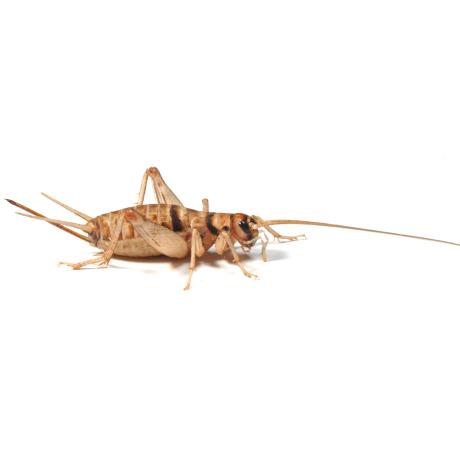

Keep your reptiles healthy and active with Banded Brown Crickets — live, gut-loaded, robust feeders in multiple sizes, sustainably bred for consistent nutrition and easy care.
Banded Brown crickets are smaller and more streamlined than the common house cricket. They’re easy to identify due to the light brown to tan bodies with darker brown horizontal bands across the abdomen. The legs are long and slender, designed for fast movment and to jump. Once adult, the wings are small and delicate, rarely used for flight.
Native to South Asia and parts of African.
Our crickets are bred in a modern, ethical facility, reared on high end food; meaning that they arrive to you fresh and in excellent health.
Banded brown crickets are easy to care for if you provide the right environment. They do best in a well-ventilated container such as a plastic tub or glass tank with a secure mesh lid. Inside, they need places to hide and climb, so cardboard egg cartons or paper tubes stacked vertically work very well. Good airflow is essential, because it prevents condensation and reduces the smell that can build up in crowded colonies.
These crickets thrive at warm temperatures, ideally between 24- 28C (75–82F). Unlike some feeder insects, they cannot be refrigerated, as they require heat to stay active. The environment should be kept relatively dry to discourage mold, but they still need a source of moisture, which can be provided safely with water gels, damp cotton pads, or slices of fresh vegetables and fruit.
Feeding is simple. A gut-loading diet of dry grains, leafy greens, and vegetables such as carrots or squash keeps them healthy and ensures they are more nutritious for reptiles. It is especially important to give them nutrient-rich foods for at least twenty-four hours before offering them as feeders, as this greatly improves their value to your animals.
Cleanliness is also key. Dead crickets and leftover food should be removed every day to avoid odor, bacteria, and mites. The enclosure should remain dry, since excess moisture quickly leads to problems with mold.
Banded brown crickets live for around six to eight weeks once they reach adulthood, so it is best to buy them in the right quantities for your needs and to keep them well fed until you use them. They can be noisy, so if you are keeping large numbers, it is wise to place their enclosure in a warm but quiet area away from bedrooms or main living spaces.
Banded brown crickets offer several advantages over other feeder insects, making them a popular choice in the reptile and amphibian industry.
Firstly, they are highly nutritious. When gut-loaded properly, they provide essential proteins, fats, and vitamins that support healthy growth, energy, and overall wellbeing in reptiles. Their relatively low fat content compared to other crickets also reduces the risk of obesity in captive animals.
Another benefit is their robustness and hardiness. Banded brown crickets are more resistant to stress during shipping and handling than many other species. They remain active longer, which increases the likelihood of live arrival and ensures that reptiles can hunt and eat them naturally, supporting natural feeding behaviors.
They are also clean and easy to manage. Unlike some crickets, they produce less odor and are less prone to spreading mites or bacteria if kept properly. Their smaller size and predictable growth make them easier to sort by size, which is crucial when feeding hatchlings, juveniles, or adult reptiles.